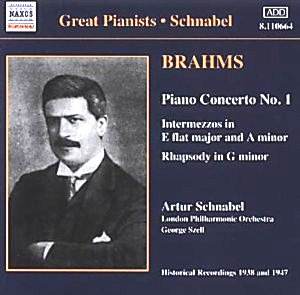No fewer than three of the finest recordings of Brahmsís
first concerto were conducted by Szell Ė the others being with Curzon
and Serkin. Indeed, Schnabel was extremely fortunate in his Brahms concerto
recordings since he had Boult as conductor for no. 2.
It is possible to feel that the tragic, impassioned
First Concerto was more suited to Szellís severe but intense,
far from unfeeling, style of conducting than any of the symphonies.
The opening tutti unfolds at a tempo fast enough to maintain onward
momentum yet with all the time in the world to express the more tranquil
moments. Against this firm background Schnabel is in magnificent form,
and I have never heard his piano sound so rich-toned. Gone is the hollow
clatter which often seems an inevitable part of the Schnabel legend;
the sound is warm and full and convincingly real. I do find the orchestral
timbres unduly strident in the upper register, but if the price for
filtering this back would have been a loss of bloom on the piano sound
then so be it. Producer Mark Obert-Thorn warns us that the original
was "miked so closely that ... the piano tone was blunt and dull."
It is so no longer and we shall probably have to accept that the performance
sounds as well now as it ever will. We need find no difficulty in appreciating
the clarity with which Schnabel reveals Brahmsís richest textures, the
natural limpidity of his phrasing and the sheer naturalness with which
he moves from point to point in a movement which often sprawls. Yes,
he catches a few crabs, but who cares.
The Adagio gives the lie to the idea that Schnabel
often took slow movements swiftly because of 78 side-lengths. When he
wanted a really slow tempo the engineers just had to find room for him!
Here he is sublimely spacious and, aided by Szellís watchful eye which
keeps things from stagnating, achieves one of the most gravely expressive
readings I have heard. The Finale is spirited but always firmly in control.
Jonathan Summersís informative note finds it necessary to defend the
pianist against charges of "snatched, lumpy phrasing" in this
movement. While I found that the corresponding movement in Schnabelís
recording of the "Emperor" sometimes falls victim to its own
impetuosity, I have to say that I found this Brahms finale full of character,
not snatched at all.
The two Intermezzi combine luminous textures
with effortless realisation of the composerís counterpoint. The central
section of op. 117/1 is a notorious quicksand for many student pianists
tempted by the "easy" outer sections. This is how it goes!
The Rhapsody penetrates Brahmsís tragic turmoil as few do. It
is a thousand pities that these three pieces are all the Brahms solo
pieces we have from Schnabel. The notes refer to an unreleased version
of the Rhapsody op. 79/1 made at the same time as these. Does it still
exist?
The legend persists that Schnabel had "no technique".
I say that, if technique means digital dexterity, anyone with ten fingers,
unlimited time and a metronome can get there in the end. But if it means
the ability to separate triplets, melody and bass-line as Schnabel does
in the G minor Rhapsody, with the clarity of a finely-rehearsed string
quartet and the sonority of a full orchestra, then he reveals a total
command over his instrument such as is given only to the very few.
Schnabel was a very complete Brahmsian indeed and these
recordings are essential documents as well as an unmissable bargain
at Naxos price.
Christopher Howell


